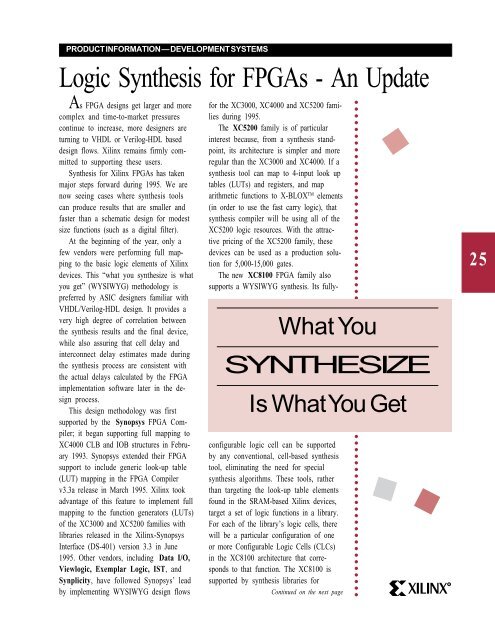Xcell on the Web - Xilinx
Xcell on the Web - Xilinx
Xcell on the Web - Xilinx
Create successful ePaper yourself
Turn your PDF publications into a flip-book with our unique Google optimized e-Paper software.
PRODUCT INFORMATION — DEVELOPMENT SYSTEMS<br />
Logic Syn<strong>the</strong>sis for FPGAs - An Update<br />
As FPGA designs get larger and more<br />
complex and time-to-market pressures<br />
c<strong>on</strong>tinue to increase, more designers are<br />
turning to VHDL or Verilog-HDL based<br />
design flows. <strong>Xilinx</strong> remains firmly committed<br />
to supporting <strong>the</strong>se users.<br />
Syn<strong>the</strong>sis for <strong>Xilinx</strong> FPGAs has taken<br />
major steps forward during 1995. We are<br />
now seeing cases where syn<strong>the</strong>sis tools<br />
can produce results that are smaller and<br />
faster than a schematic design for modest<br />
size functi<strong>on</strong>s (such as a digital filter).<br />
At <strong>the</strong> beginning of <strong>the</strong> year, <strong>on</strong>ly a<br />
few vendors were performing full mapping<br />
to <strong>the</strong> basic logic elements of <strong>Xilinx</strong><br />
devices. This “what you syn<strong>the</strong>size is what<br />
you get” (WYSIWYG) methodology is<br />
preferred by ASIC designers familiar with<br />
VHDL/Verilog-HDL design. It provides a<br />
very high degree of correlati<strong>on</strong> between<br />
<strong>the</strong> syn<strong>the</strong>sis results and <strong>the</strong> final device,<br />
while also assuring that cell delay and<br />
interc<strong>on</strong>nect delay estimates made during<br />
<strong>the</strong> syn<strong>the</strong>sis process are c<strong>on</strong>sistent with<br />
<strong>the</strong> actual delays calculated by <strong>the</strong> FPGA<br />
implementati<strong>on</strong> software later in <strong>the</strong> design<br />
process.<br />
This design methodology was first<br />
supported by <strong>the</strong> Synopsys FPGA Compiler;<br />
it began supporting full mapping to<br />
XC4000 CLB and IOB structures in February<br />
1993. Synopsys extended <strong>the</strong>ir FPGA<br />
support to include generic look-up table<br />
(LUT) mapping in <strong>the</strong> FPGA Compiler<br />
v3.3a release in March 1995. <strong>Xilinx</strong> took<br />
advantage of this feature to implement full<br />
mapping to <strong>the</strong> functi<strong>on</strong> generators (LUTs)<br />
of <strong>the</strong> XC3000 and XC5200 families with<br />
libraries released in <strong>the</strong> <strong>Xilinx</strong>-Synopsys<br />
Interface (DS-401) versi<strong>on</strong> 3.3 in June<br />
1995. O<strong>the</strong>r vendors, including Data I/O,<br />
Viewlogic, Exemplar Logic, IST, and<br />
Synplicity, have followed Synopsys’ lead<br />
by implementing WYSIWYG design flows<br />
for <strong>the</strong> XC3000, XC4000 and XC5200 families<br />
during 1995.<br />
The XC5200 family is of particular<br />
interest because, from a syn<strong>the</strong>sis standpoint,<br />
its architecture is simpler and more<br />
regular than <strong>the</strong> XC3000 and XC4000. If a<br />
syn<strong>the</strong>sis tool can map to 4-input look up<br />
tables (LUTs) and registers, and map<br />
arithmetic functi<strong>on</strong>s to X-BLOX TM elements<br />
(in order to use <strong>the</strong> fast carry logic), that<br />
syn<strong>the</strong>sis compiler will be using all of <strong>the</strong><br />
XC5200 logic resources. With <strong>the</strong> attractive<br />
pricing of <strong>the</strong> XC5200 family, <strong>the</strong>se<br />
devices can be used as a producti<strong>on</strong> soluti<strong>on</strong><br />
for 5,000-15,000 gates.<br />
The new XC8100 FPGA family also<br />
supports a WYSIWYG syn<strong>the</strong>sis. Its fully-<br />
What You<br />
SYNTHESIZE<br />
Is What You Get<br />
c<strong>on</strong>figurable logic cell can be supported<br />
by any c<strong>on</strong>venti<strong>on</strong>al, cell-based syn<strong>the</strong>sis<br />
tool, eliminating <strong>the</strong> need for special<br />
syn<strong>the</strong>sis algorithms. These tools, ra<strong>the</strong>r<br />
than targeting <strong>the</strong> look-up table elements<br />
found in <strong>the</strong> SRAM-based <strong>Xilinx</strong> devices,<br />
target a set of logic functi<strong>on</strong>s in a library.<br />
For each of <strong>the</strong> library’s logic cells, <strong>the</strong>re<br />
will be a particular c<strong>on</strong>figurati<strong>on</strong> of <strong>on</strong>e<br />
or more C<strong>on</strong>figurable Logic Cells (CLCs)<br />
in <strong>the</strong> XC8100 architecture that corresp<strong>on</strong>ds<br />
to that functi<strong>on</strong>. The XC8100 is<br />
supported by syn<strong>the</strong>sis libraries for<br />
C<strong>on</strong>tinued <strong>on</strong> <strong>the</strong> next page<br />
○ ○ ○ ○ ○ ○ ○ ○ ○ ○ ○ ○ ○ ○ ○ ○ ○ ○ ○ ○ ○ ○ ○ ○ ○ ○ ○ ○ ○ ○ ○ ○ ○ ○ ○ ○ ○ ○ ○ ○ ○ ○ ○ ○ ○ ○ ○ ○ ○ ○ ○ ○ ○ ○ ○ ○ ○ ○ ○ ○ ○ ○ ○ ○ ○ ○ ○ ○ ○ ○ ○ ○ ○ ○ ○<br />
R<br />
25

















